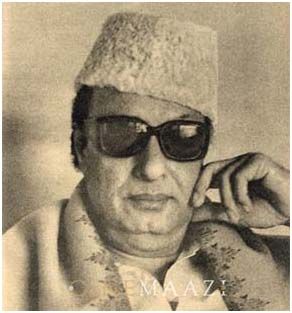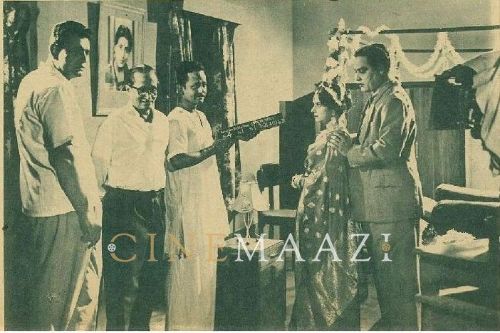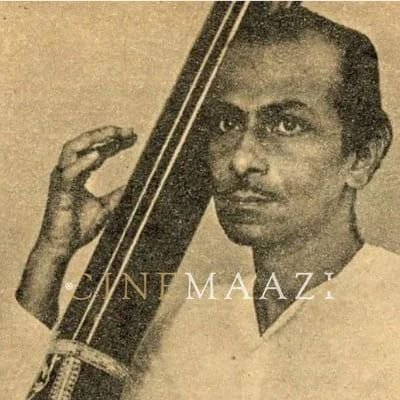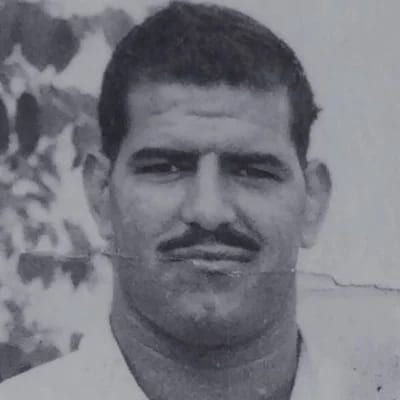M G Ramachandran

Subscribe to read full article
This section is for paid subscribers only. Our subscription is only $37/- for one full year.
You get unlimited access to all paid section and features on the website with this subscription.
Not ready for a full subscription?
You can access this article for $2 , and have it saved to your account for one year.
- Real Name: Marathur Gopala Ramachandran
- Born: 17 January, 1917 (Kandy, Sri Lanka)
- Died: 24 December, 1987 (Chennai)
- Primary Cinema: Tamil
- Parents: Melakkath Gopalan Menon, Marathur Satyabhama
- Spouse: V N Janaki , Chitarikulum Bargavi, Sadhanandavathi
The term megastar does not suit everyone, but if there is one actor in the history of Tamil cinema it fits to a T, it is M G Ramachandran. Popularly known as MGR, he left an unparalleled legacy in the spheres of both cinema and politics. From the late 40s till the 70s, he was the undisputed numero uno star of the Tamil film industry, delivering some of its biggest hits in history. Called Puratchi Thalaivar by his admirers, he became a near God-like figure in Tamil Nadu, commanding a fan following that has not been matched since. His films were often predicated on portraying him as a protector of oppressed peoples, often overcoming insurmountable odds with superhuman feats of strength and determination. A key figure in the history of Dravidian politics in Tamil Nadu, his falling out with Dravida Munnetra Kazhagam chief M Karunanidhi led to the foundation of the All India Anna Dravida Munnetra Kazhagam. Riding on the wave of his popularity, he went on to serve three terms as Chief Minister of Tamil Nadu, though his tenures were marked with controversies.
Born Marathur Gopala Ramachandran in Kandy, Sri Lanka on 17 January, 1917 to Melakkath Gopalan Menon and Marathur Satyabhama, it will be a surprise to many that MGR was actually born in a Malayali family and was not Tamilian by birth. His father passed away while he was quite young, as well as his sister. Struggling with poverty, his mother returned to Kerala. When her relatives refused her aid, Velu Nair of Kumbakonam helped to put her children in school. At only six years of age, MGR displayed an affinity towards acting when he joined the Madurai Original Boys theatre group. His elder brother M G Chakrapani was also part of the troupe. He was trained in dancing, acting and sword-fighting while he was with them. He also played female roles in plays, including during a visit overseas with the help of Madras Kandasamy Mudaliar. When he returned to India, he graduated to playing lead roles. At this point he was influenced by Gandhi and had joined the Indian National Congress.
He made his film debut with Ellis Duncan's Sathi Leelavathi (1936). He had to struggle for years as an actor, before he got a major role Rajakumari (1947). It was 1950's Manthiri Kumari that proved to be a turning point in his career. Based on a Tamil epic, the film followed closely the DMK ideology, and was written by M Karunanidhi. It proved a landmark film for the careers of multiple people, including singer T M Soundarajan, the villain Nambiar and Madhuri Devi. The huge success of the film shot MGR to stardom. By 1953, MGR had left the Congress and joined the DMK.
More onscreen success followed with films like Marmayogi (1951), Malaikkallan (1954), Gul-e-Bakaavali (1955), the Gevacolor Alibabavum 40 Thirudargalum (1955), Madurai Veeran (1956), Nadodi Manan (1958), Thirudathe (1961), Periya Idathu Penn (1963), Panathottam (1963), Padakotti (1964), Enga Veettu Pillai (1965), Anbe Vaa (1966) and many more. According to historian MSS Pandian, many of these films featured MGR challenging class and caste hierarchies, striving for education and dismantling his opposition with ease. MGR was the solution to society's ills, dispensing justice in a way unimaginable in reality. This was reflected in the iconography of the fight sequences and the role of his character in the narrative. He also played many popular figures from Tamil history, often adapting famous stage plays. He won the National Award for his performance in Rickshawkaran (1971) which was later remade in Hindi as Rickshawala (1973). He also won two Filmfare Awards South for Adimai Penn (1969) and Enga Veettu Pillai. He also won the Tamil Nadu State Film Award for Kudiyirundha Koyil (1968) and Adimai Penn. He and Karunanidhi had also started a production house called Mekala Pictures.
By the mid-50s, MGR had become the press spokesperson of the DMK and in 1962, a member of the legislative council. This rise in ranks was facilitated by the split between the party and Sivaji Ganesan, whose stardom had preceded MGR's. After party chief C N Annadurai's death, MGR played a key role in Karunanidhi's rise to power. He was appointed Party Treasurer in 1970. But soon a power struggle emerged between Karunanidhi and MGR. This was worsened by Karunanidhi's attempts to further the acting and political career of his son M K Muthu. MGR also opposed the repealing of the state's alcohol prohibition laws by Karunanidhi. In 1972, MGR filed corruption charges against the party leadership, even seeking members of the DMK to publicly declare their assets. This led to his ouster from the party, but not before he had gained significant political ground himself.
In 1967, he survived a sensational assassination attempt by M R Radha. The attempt left him without hearing in his left ear. After his recovery, he acted in Kaavalkaran (1967) but his speaking parts were reduced. His co-star in Kaavalkaran was his future protege Jayalalithaa. His hospitalisation saw a massive public outpouring of grief. He also won the MLA elections from his hospital bed.
Preminda Jacob notes that MGR was especially deft at translating his cinematic persona into the political field. This was done by him donning the garb of his onscreen characters during parades and rallies and threading in dialogues from his films into his speeches. Another remarkable aspect of his stardom was his amazing hold over Tamil film fan clubs. MGR transformed these fan clubs into political mobilising forces, who prepared the grounds of local electoral campaigns. In many ways MGR's political persona had become indistinguishable from his onscreen one in the fans' eyes. MSS Pandian notes how watching an MGR film had become akin to partaking in a ritual. In the face of social injustice and marginalisation, MGR had become the answer.
In 1972 he formed the Anna Dravida Munnetra Kazhagam (ADMK), promising a return to the ideals of C N Annadurai. His films during this period were used to further his political ideas and attack his rivals. Some examples were Netru Indru Maalai (1974) and Idhayakani (1975). Many of these films turned the DMK's film propaganda techniques against them. But he acted in fewer films, and from 1978 his political career had completely taken over. In 1977, the ADMK-CPI(M) alliance defeated the DMK in elections and came to power. MGR became the Chief Minister on 30 June, 1977. Later the name of the party was changed to All India Anna Dravida Munnetra Kazhagam (AIADMK) to show support for the 1980 Indira Gandhi government. In 1984, MGR suffered a paralytic stroke. In the lead up to the elections, a video was shown juxtaposing MGR in the hospital with Indira Gandhi's assassination. Needless to say, an AIADMK-Congress alliance won a landslide victory in the elections.
MGR's three reigns as Chief Minister - 1977, 1980 and 1984, were not without controversies. Critics have described his regime as a police state, often curbing any kind of dissent. He had been accused of preferring welfare schemes over long term infrastructural changes. This time was also marked by a significant economic stagnation of the state of Tamil Nadu. The MGR's Nutritious Meal Scheme was deemed a success. He also introduced a state-wide liquor ban, and boosted the tourist industry. He also set up a free school for the children of film technicians. He had also been accused of extending support to the LTTE struggle in Sri Lanka, though his political opponent Karunanidhi also faced similar charges.
His later political career was marked by his encouragement of Jayalalithaa's entrance into politics. She had acted with him in nearly 20 films. This led to some dissidence in his party, but also prepared the stage for Jayalalithaa's eventual ascension to the top of the Tamil Nadu political pyramid.
MGR was married thrice. He was married to Chitarikulum Bargavi, also known as Thangamani in 1939, but she passed away in 1942. He later married Sadhanandavathi in 1942 and the two stayed married for 20 years till her death in 1962. In 1963 he married V N Janaki, an actress and later political activist. After his death a bitter faction feud had ensued within the AIADMK between V N Janaki and Jayalalithaa. Janaki’s faction even won the elections, but her government was dismissed in just 24 days after the AIADMK failed to win enough seats in the state assembly. This led to a period of political instability before the DMK emerged victorious.
MGR passed away on 24 December, 1987. His funeral in January was attended by over two million people. Never before had such massive mourning been observed over any public figure in the state. It even led to multiple incidents of violence. There were also reports of fans committing suicide in grief. He was posthumously awarded the Bharat Ratna in 1988. His remains were buried at Marina Beach in the MGR Memorial. Since his death several honours have been bestowed on him by both the Tamil Nadu and Indian government. His friendship and subsequent rivalry with Karunanidhi is widely documented and was the subject of the Mani Ratnam film Iruvar (1997). Remarkably, even after their fallout, MGR continued to address Karunanidhi as Andavanae.
MGR’s legacy as a star is practically unmatched in the history of Tamil Nadu. For years after his passing, he remained a near divine figure for people, and his name held significant political currency. Jayalalithaa, in her political career, often drew on the same cinematic techniques used by MGR in his time. Despite the many criticisms of his government, he still remains Puratchi Thalaivar (revolutionary leader) to many.
-
Filmography (75)
SortRole
-
Janma Hakku 1980
-
Golconda Gajadonga 1980
-
Ganga Ki God Mein 1978
-
Love In Kaashmir 1976
-

Rangeen Duniya 1975
-
Aakhiri Nishaan 1974
-








.jpg)




